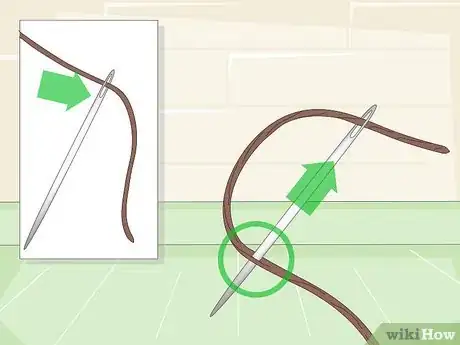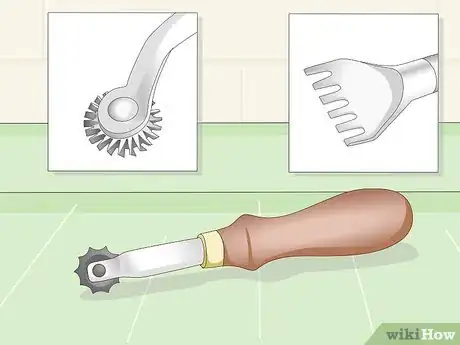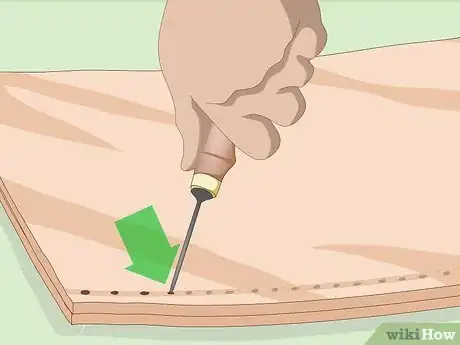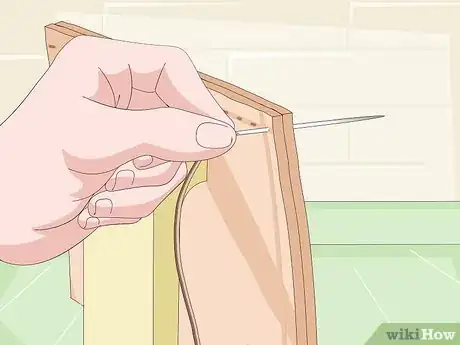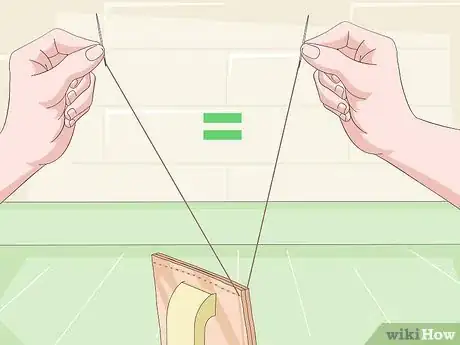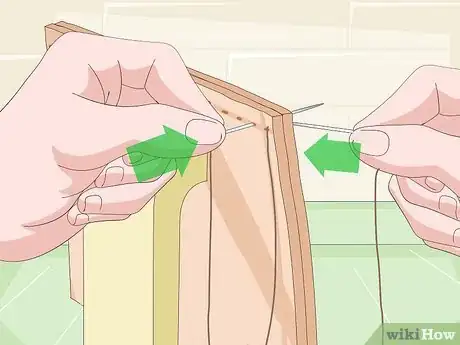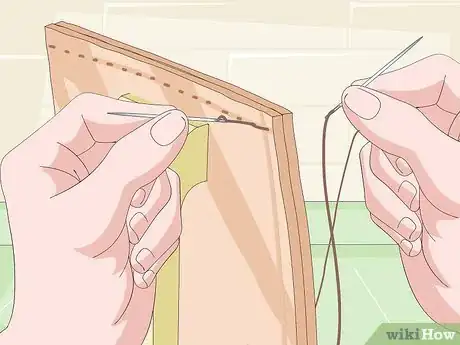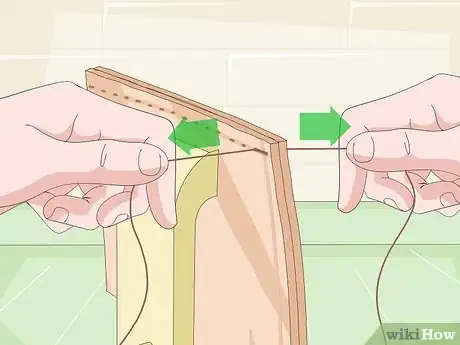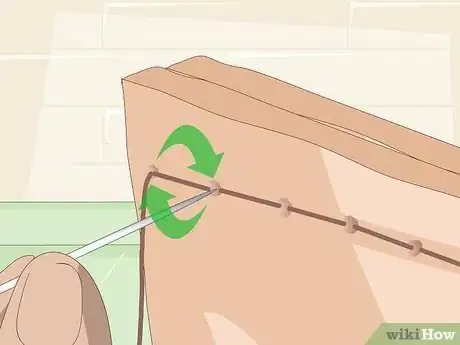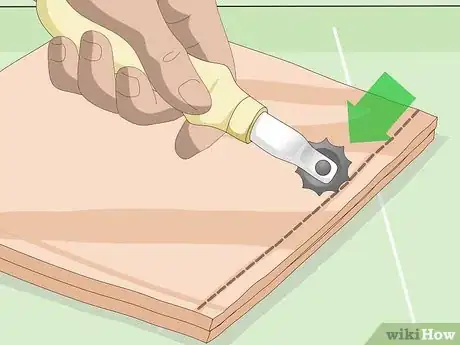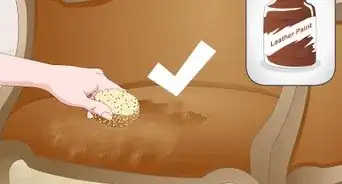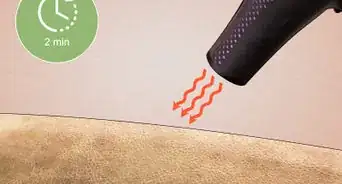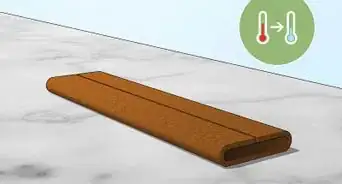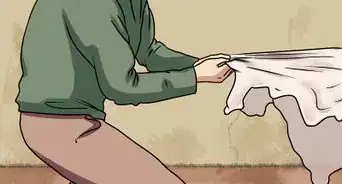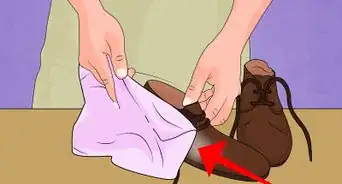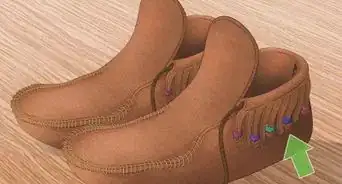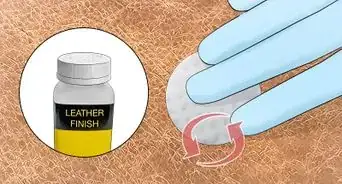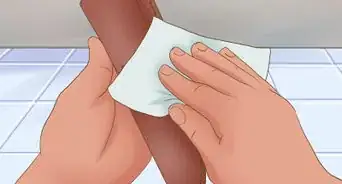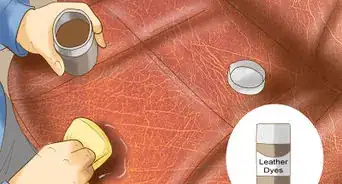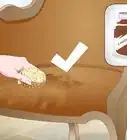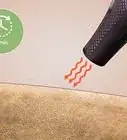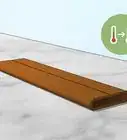This article was co-authored by Mallika Sharma. Mallika Sharma is a Certified Leather Care Technician and the Founder of The Leather Laundry, a niche spa service for luxury leather gear in India. Mallika specializes in leather cleaning, coloring, repairing, and restoring for shoes, handbags, jackets, wallets, belts, and sofas. She holds a Master’s degree in Finance and Investment from the University of Edinburgh Business School. Mallika is a certified Professional Leather Care Technician and trained with the globally reputed leather care company, LTT in the United Kingdom.
wikiHow marks an article as reader-approved once it receives enough positive feedback. In this case, 97% of readers who voted found the article helpful, earning it our reader-approved status.
This article has been viewed 126,532 times.
Sewing leather by hand makes for a traditional and handsome project. Stitching through leather is not as difficult as it may seem. Whether your leather project is large or small it can be simple. Gather a few important tools and learn how to saddle stitch to create your own leather products.
Steps
Preparing the Project for Stitching
-
1Glue your pieces of leather together. Use a leather glue on the edges you will be stitching together. Glue between each layer if your are stitching more than two pieces of leather.[1]
-
2Lock the thread to the needle. Pull several inches of thread through the eye of the needle. About one inch from the edge of the thread, push the tip of the needle through the center of the thread, puncturing it. Pull this punctured portion of thread up the length of the needle back toward the eye. Pull the short end of the thread over the long piece and past the eye of the needle, creating a knot to lock your thread.[2]
- Cut the thread at a slant to make it easier to thread it through the eye of the needle.
- Once you pull the punctured thread back toward the eye, if you have a large loop between the eye and the punctured thread, pull back on the long portion of the thread to draw the loop back through the eye before pulling the short end past the eye to create the know.
- Repeat this process on the other end of the thread with another needle so that you have a needle on either end of the thread to complete saddle stitches.
- Attempt to supply enough thread to complete the entire project without having to cut and rethread the needles. This should be at least 3 times the length of your seam and more if your project is particularly thick.
Advertisement -
3Create a stitching line on your leather. This will guide your stitching in a straight line. Stitches can run in a line or a groove. If you use a groove, once the stitches pull tight, they will lie beneath the surface of the leather and be more protected from wear and friction.[3]
- Dig a groove in the leather using a grooving tool. Slide the guide to the distance you would like your groove to be dug from the edge of the leather. Lock the guide in place. Set the guide against the edge of the leather and pull the grooving tool from one end to the other. A small amount of the leather will be scraped off to leave a groove in your project. Repeat this process on the other side.
- Using wing dividers, also known as a creaser, set them at the distance you would like the line to be drawn from the edge of the leather. Draw the dividers from one end of the leather to the other with one wing along the edge and the other marking a scratch in the leather to serve as your stitching line.
-
4Choose a tool to mark your stitches. There are several tools available to make marking stitches easy and accurate. Try several tactics and choose the tool you are most comfortable using.
- Over-stitching wheels make dips in the leather to stitch on as well as being used to run over the stitch to press it into the leather once the stitching is complete. These come in different sizes, the number relates to the number of stitches per inch.
- Pricking wheels poke holes along the stitching line. Do not use this to run back over the project once the stitching is complete, as the sharp edges will damage the thread. These come in different sizes, the number relates to the number of stitches per inch.
- Diamond hole punches create a series of marks which match the shape of the diamond awl you will push through. Some of these hole punches are able to puncture all the way through both sides of the leather to create holes on both sides.
-
5Mark your stitches. Determine how far apart you would like the stitches. Longer stitches should be used in larger projects, with the stitch distance scaling down with the size of the project. Mark the stitches using the tool you chose scaled appropriately to your project.
- To use an over-stitching wheel, start at the beginning of the stitching line. Place the wheel firmly on the line and using a little pressure, push the wheel along your stitching line to create the bumps where you will puncture holes to stitch through.
- Place your pricking wheel at beginning of the stitching line. Press the wheel firmly on the line and using a little pressure, push the wheel along your stitching line to prick the holes you will stitch through. These holes will need to be punctured again with a diamond awl.
- Place the points of the diamond hole punch along your stitching line. Hold it firmly in place with one hand, while you use the other hand to hammer onto the top of the iron to puncture holes in the leather to stitch through. If you need more stitching marks than the length of the iron, place the end prong in the last mark to keep the spacing even and continue hammering along your stitching line until you have enough marks to complete your project.
-
6Puncture stitching holes through the stitching marks. Using an awl, press it through the marks to make a hole to stitch through. This could require a lot of pressure if you are puncturing through several layers of leather. Make sure each whole goes all the way through each layer.
- If you used a diamond hole punch with deep enough tines, it is possible this can puncture all the way through to create the holes while making the marks, making this step unnecessary.
-
7Clamp your project into a lacing pony. Place the item between the jaws of the pony with the stitching line just above the jaws. Clamp the jaws tightly enough to hold your project firmly in place while you work on it.[4]
- If it is a large project which won't fit in the pony, you will need to use a stitching horse.
Saddle Stitching Leather
-
1Push one needle from the front of the project to the back. The needle should fit easily through the hole you have created. Push it all the way through every layer of leather and draw it completely out the back side.
-
2Center the thread. Pull both needles out the the side until the center of the thread is in the first hole. Draw both needles upward and match to points to make sure the thread is centered.
-
3Begin your first stitch. Push the front needle from front to back through the second hole. Once the majority of the needle is through the hole, place your other needle below it so that you can grab the stitching needle with your thumb and forefinger the pull it the rest of the way through the hole.
-
4Complete the stitch. Take the second needle which you had placed on the bottom of the other needle, turn it toward the project and push it back to front through the bottom of the same hole the first needle just came through.
- When drawing this second needle out of the front, feed some of the original thread already in the hole out in the same direction you are pulling the needle. This will ensure that you do not puncture the thread.
- If you do puncture the thread, draw the needle back out of the thread, then back through the bottom of the hole.
-
5Pull the stitch tight. Gently tug outward on both ends of the thread to tighten the stitch before moving on to the next hole. You should have an even amount of thread on both sides. Pull slightly up on the back thread and slightly down on the front thread.
-
6Repeat this stitching process until you have reached the end of your seam. Always start from the front of the project with the first needle.
Finishing Your Stitches
-
1Back-stitch the end of the seam. Starting from the front of the project, push the first needle through the second to last stitching hole. This time, once the needle is most of the way through the hole, place the other needle on top of the first and pull it the rest of the way through the hole. Turn this second needle back toward the leather, and this time push it through the top of the hole.
- This will be a little more difficult since there is already thread in the hole.
- Repeat the back-stitch 2 or 3 times depending on the amount of stress which will be put on the seam in this area.
-
2Finish the stitch. Once you have completed 2 or 3 back-stitches, you can release the needle on the back of the project. Push the front needle through the next hole, leaving both threads on the back of the project one hole apart. Pull each thread tight. Using a sharp knife, tilted slightly upward to avoid damaging the stitched thread, cut off the extra thread as close to the leather as possible, leaving only a little nub where the threads came through the hole.
- It is not necessary to tie a knot in the thread.
- Nylon thread can be melted by adding a little heat from a flame, then press them into place for extra hold.
-
3Flatten the thread along the seam. Roll back over the thread with your over-stitching wheel or gently tap along the seam with a flat headed hammer like a cobbler's hammer.
Community Q&A
-
QuestionWhere can I find vegetable-tanned leather?
 Community AnswerAt your nearest fabric store or leather shop.
Community AnswerAt your nearest fabric store or leather shop.
References
- ↑ https://www.youtube.com/watch?v=8N_9w1v884g
- ↑ Mallika Sharma. Certified Leather Care Technician. Expert Interview. 7 January 2021.
- ↑ http://unblinkingeye.com/Guns/LTools/ltools.html
- ↑ http://unblinkingeye.com/Guns/LTools/ltools.html
About This Article
To sew leather by hand, start by gluing the edges you’ll be stitching together and using an over-stitching wheel to mark your stitches. Next, punch holes through the stitching marks with an awl, clamp the leather into a lacing pony, and knot the ends of your thread onto 2 separate needles. Then, push 1 needle through the leather and pull both needles upward until the center of the thread is in the hole. Sew your stitches by pushing the front needle most of the way through the hole, then placing the other needle below the first needle and pushing it through. To learn how to finish your stitches once you reach the end of the seam, read on.

